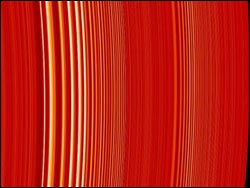Saturn’s ring waves

Saturn’s ring waves
This false-colour image of two density waves in Saturn’s A ring was taken by the NASA/ESA/ASI Cassini-Huygens spacecraft at a distance of 6.8 million kilometres from Saturn.
The image was made from the stellar occultation observed by the Cassini-Huygens Ultraviolet Imaging Spectrograph, and shows a section of rings about 724 kilometres across and the smallest features about half a kilometre across.
Bright areas indicate the denser regions of the rings. The bright bands in the left part of the image are the ’peaks’ of a density wave caused by gravitational stirring of the rings by Saturn’s moon Janus.
A smaller density wave in the right half of the image is produced by the moon Pandora. The Ultraviolet Imaging Spectrograph observed the brightness of the star Xi Ceti as the rings passed in front of it, and the flickering of the starlight was converted into the ring density depicted by the image.
The Cassini-Huygens mission is a co-operative project of NASA, ESA and ASI, the Italian space agency.
Media Contact
More Information:
http://www.esa.intAll latest news from the category: Physics and Astronomy
This area deals with the fundamental laws and building blocks of nature and how they interact, the properties and the behavior of matter, and research into space and time and their structures.
innovations-report provides in-depth reports and articles on subjects such as astrophysics, laser technologies, nuclear, quantum, particle and solid-state physics, nanotechnologies, planetary research and findings (Mars, Venus) and developments related to the Hubble Telescope.
Newest articles

A universal framework for spatial biology
SpatialData is a freely accessible tool to unify and integrate data from different omics technologies accounting for spatial information, which can provide holistic insights into health and disease. Biological processes…

How complex biological processes arise
A $20 million grant from the U.S. National Science Foundation (NSF) will support the establishment and operation of the National Synthesis Center for Emergence in the Molecular and Cellular Sciences (NCEMS) at…

Airborne single-photon lidar system achieves high-resolution 3D imaging
Compact, low-power system opens doors for photon-efficient drone and satellite-based environmental monitoring and mapping. Researchers have developed a compact and lightweight single-photon airborne lidar system that can acquire high-resolution 3D…





















